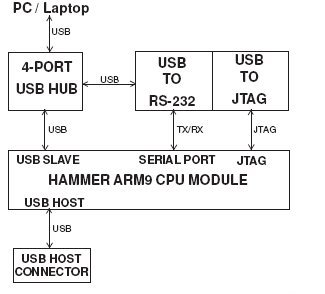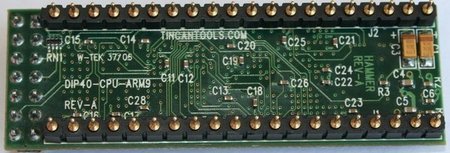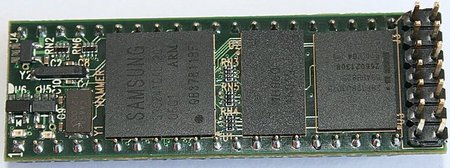Portable ARM-based kit targets USB gadget prototyping
Apr 18, 2008 — by Eric Brown — from the LinuxDevices Archive — 10 views Like to build software for ARM-based development targets on the go? Tin Can Tools is readying a tiny, “unbrickable” Linux USB Gadget software development kit that can also be used as a sturdy, USB bus-powered development target for general ARM device prototyping, application testing, and experimentation.
Like to build software for ARM-based development targets on the go? Tin Can Tools is readying a tiny, “unbrickable” Linux USB Gadget software development kit that can also be used as a sturdy, USB bus-powered development target for general ARM device prototyping, application testing, and experimentation.
(Click for larger view of Nail Kit (with Hammer module))
The Nail Kit appears to be primarily intended as a development platform for USB Gadget software. It comes pre-loaded with Linux and USB gadget software enabling it to present itself to the development host as an Ethernet device for SSH logins. Other included USB gadget software lets the Nail Kit emulate a USB flash storage device or a second serial port. Or, you could use the Kit to test USB gadget software of your own.
Plugged into a laptop via a single cable, the Nail Kit could also be used as a general-purpose ARM prototyping platform, evaluation tool, educational device, or just a cool toy for hobbyists, Tin Can says. An available plastic tube case (shown above) protects the two-board stack from jostling laptop contents, moisture, static electricity, and the other ills that normally keep ARM dev boards office-bound.
The Kit comprises the company's ARM920T-based “Hammer” SBC (single-board computer), along with the “Nail Board” carrier board. The carrier's onboard JTAG device makes the device “unbrickable,” Tin Can says, since developers can use it to download not only device firmware, but a bootloader as well.


Nail Kit, top and bottom
(Click either to enlarge)

Nail Kit block diagram
The Nail Kit's Linux-based Hammer CPU module measures only 0.75 x 2.25 inches (see images below). It is based on a Samsung S3C2410A SoC (system-on-chip) that integrates a 200MHz ARM920T core with a memory management unit (MMU), and 16KB each of instruction and data cache.
The Hammer is also equipped with 16MB of NOR flash soldered onboard, along with 32MB of 100MHz SDRAM. Instead of bringing I/O out to high-density surface-mount connectors, the Hammer offers 40 solder-friendly 0.1-inch pins for easy prototyping of complex designs, says the company.


The “Hammer” has 40 I/O pins on the bottom, and a 2 x 7 pin JTAG interface on top
(Click any to enlarge)
The following are the specifications provided for the Nail Kit. For more specs on the Hammer that plugs into it, please refer to our in-depth coverage, here:
- Male and female (upstream and downstream) USB connectors
- USB JTAG device (via internal FT2232)
- USB Hub
- USB serial port console (via FT2232)
- USB controlled GPIOs
- USB gadget interface (via Hammer) with gadget drivers for Ethernet, serial port, and storage
- USB 1.1 host interface (via Hammer) with low- (2Mb) and full-speed (12Mb)
- LEDs — 2 x on Nail Board; 2 x on Hammer
- 2 x interrupt-driven pushbutton switches
- User-controlled PWM buzzer
- Reset button
- Expansion header (20-pin: 2 x10) — +5V and +3.3V; 2 SPI ports; 2-wire serial port (TX/RX); GPIOs; external interrupts; headers can be jumper configured
- Hammer breakout header — access to all 40 I/O pins; 0.1-inch headers
- USB cable assembly
- Operating system — custom Linux distribution (Linux 2.6.2x); uClibc; BusyBox; DropBear
Availability
The Nail Kit is generally available for $190, but was not yet in stock at press-time. More information may be available here.
This article was originally published on LinuxDevices.com and has been donated to the open source community by QuinStreet Inc. Please visit LinuxToday.com for up-to-date news and articles about Linux and open source.